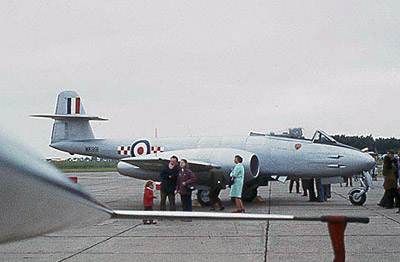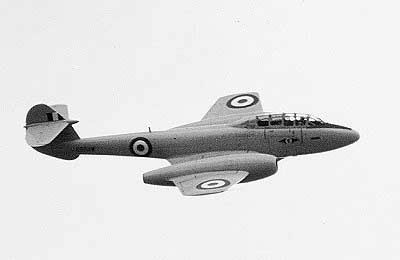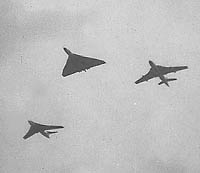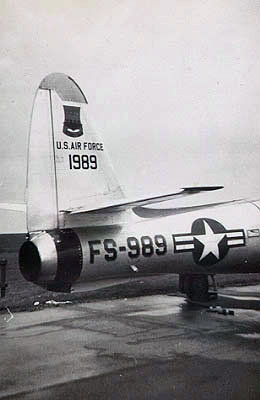 Part
Two: A Meteoric rise, the early fifties
by
Dave Eade
Part
Two: A Meteoric rise, the early fifties
by
Dave Eade
If anyone is to blame, it is my brother!
I was brought up in a family of aircraft spotters. My father, being an ex-Observer Corps member, passed his interest onto my brother (some eleven years my senior), who also joined the Royal Observer Corps. He taught me all I knew in my youth about aviation, and took me to my first airshow, at RAF Horsham St Faith (now Norwich Airport). I do not remember the date, only the attending F-86 and C-119, but the journey was terribly complicated, in that it involved both a train ride to Norwich and a bus to the airfield.
In those days Wattisham was very active. This was the age of the Meteor, with the arrival of 245 Squadron, later backed up by 56 and 266 Squadrons. Equipped with the Mark 3 version, the activity reached its peak in 1951 with the arrival of the Mk 8s of 257 and 263 Squadrons, each squadron also having a T7 trainer for check-rides. Both squadrons took part in the Coronation flypast of 1953, while the airfield's capability was enhanced in 1954 with the arrival of 152 Squadron and its night fighters in the form of NF12s and 14s.
Air force flying life seemed very free
in those days with a vast number of types working from the station. My
first visits there were to watch Mk 8s, which seemed to go for the three
pointer landing rather than the nose-up two pointer that is the norm today.
The station had its Anson, as did most, and it was common to see Brigand,
 Consul
(military Oxford) and the occasional Dominie – no, not the Red and
white biz-jet but the Dragon Rapide in its military colours. Other common
types were Tiger Moths, Chipmunks and very occasionally Balliols on cross-country
exercises from the Flying Training Schools of central England.
Consul
(military Oxford) and the occasional Dominie – no, not the Red and
white biz-jet but the Dragon Rapide in its military colours. Other common
types were Tiger Moths, Chipmunks and very occasionally Balliols on cross-country
exercises from the Flying Training Schools of central England.
The annual Battle of Britain displays were very much a family event, with coaches bringing people in from all the surrounding villages. EVERYBODY went to the 'At Home' days – old and young. You would see everyone you knew there – people with no knowledge or interest in aviation – but there for what was probably the last day out of the summer. It always seemed to coincide with the swarms of Cranefly that we see in September – why do I remember that!
People that read their newspapers were 'in the know' as far as aircraft went, and these days of the fifties were the time when Britain was a world player in the manufacturing stakes. Two events spring to mind – first the appearance, albeit static only, of the only Short Sperrin – which I believe was on trials at Martlesham Heath, and the second based on the fact that the 'Sound Barrier' was the expression on everybody’s aircraft lips. Farnborough had seen the Hunters, DH110 and the like all competing to produce the best supersonic bang – this came to Wattisham in the form of my first sighting of an RAF Hunter, which produced a loud double bang over the crowd at one show. Not to be out-done, the Station Flight Meteor T7 flew low over the runway wheels down, flaps down while some young NCO let off two thunderflashes – but I don’t remember being convinced.
 Compared
to today's few displays, Wattisham was a fixed yearly event – as
was Honington, Felixstowe, Martlesham Heath, et al. Virtually all the
stations in the country were open on 'Battle of Britain Day' to the public.
This justified the flying of large formations of all types of aircraft
around the country on a five-minute apart circuit, to take in all the
bases open. One wonders how on earth these formations made it, but it
was truly nothing to see box-fours of Beverleys, Britannias, Shackletons,
Lincolns, and from the Fleet Air Arm I remember Attackers and Sea Hawks.
Big formations from the based Squadrons working out of the revetments
would pull their way into the sky, orbit Suffolk before returning for
a couple of passes before
Compared
to today's few displays, Wattisham was a fixed yearly event – as
was Honington, Felixstowe, Martlesham Heath, et al. Virtually all the
stations in the country were open on 'Battle of Britain Day' to the public.
This justified the flying of large formations of all types of aircraft
around the country on a five-minute apart circuit, to take in all the
bases open. One wonders how on earth these formations made it, but it
was truly nothing to see box-fours of Beverleys, Britannias, Shackletons,
Lincolns, and from the Fleet Air Arm I remember Attackers and Sea Hawks.
Big formations from the based Squadrons working out of the revetments
would pull their way into the sky, orbit Suffolk before returning for
a couple of passes before  landing.
The USAFE would not be done out of a show either, providing F-84s,
F-86s and usually a C-119. Pride of place, because it smoked the most,
would go the Tornado – no, not the swinger from Cottesmore, but a
Sculthorpe based B-45! These were incredible aircraft, and a common sight
in East Anglia.
landing.
The USAFE would not be done out of a show either, providing F-84s,
F-86s and usually a C-119. Pride of place, because it smoked the most,
would go the Tornado – no, not the swinger from Cottesmore, but a
Sculthorpe based B-45! These were incredible aircraft, and a common sight
in East Anglia.
Exercises were kept secret in those days – no Mil-Spotters then! I used to find out because the ROC would be on exercise as well, plotting low-flying 'Rats' attempting to evade the radar cover. News of an event was always leaked, at home, by my brother, who would then swear me to secrecy, otherwise you-know-what will happen!
I was occasionally allowed into the 'Post' of the Royal Observer Corps at Combs, which was great because you had a pretty good idea of what was coming. I remember seeing and F-84 Thunderjet literally spring out of the valley to the south of Stowmarket, at what seemed no height at all, to carry out an attack on the unsuspecting Wattisham.
1954 saw the end of the Meteor era with the night fighters going off to Stradishall while the day-fighter squadrons awaited the new pearl from Hawker, the Hunter F2 arriving for 257 Squadron in the November. The story of the Hunter years follows in part three.